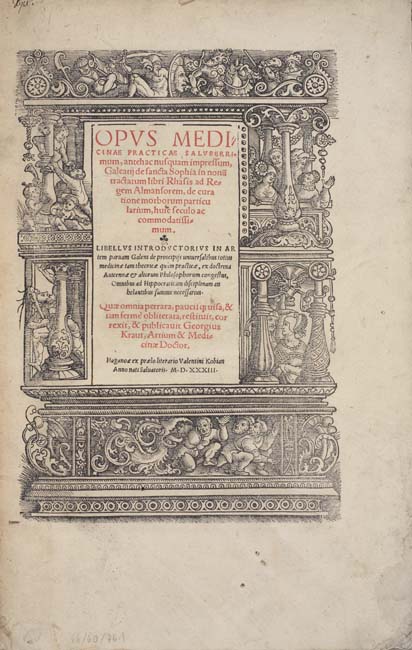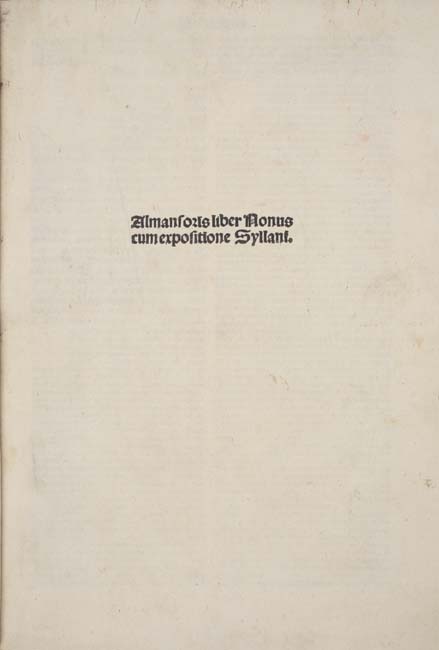RHAZES [Abu Bakr Muhammad ibn Zakkariyya al-Razi] (ca. 854-925). Liber ad Almansorem . - Liber divisionum . - Tractatus de egritudinibus iuncturarum . - Capitulum de curis puerorum in prima etate . Liber de secretis in medicina . Translated from Arabic into Latin by Gerard of Cremona (ca. 1114-87). GALENUS (129-ca. 200/216). Liber de medicinis experimentatis . - [MESU (ca. 777-857)]. Aphorismi Johannis Damasceni. - HIPPOCRATES (460-ca. 370 B.C.). Liber de humana natura vel de elementis . - Liber de aere et aqua et regionibus . - Libellus de pharmaciis . - RHAZES. De sectionibus et cauteriis et ventosis . - Synonyma . - Tabula de herbis medicis et electuariis . Milan: Leonardus Pachel and Uldericus Scinzenzeler, 14 February 1481. Median 2 o (332 x 232 mm). Collation: s6 a-l 8 m 4 n-z 8 ( blank, r table, a1r Liber Almansoris , o8v blank, p1r Rhazes, Liber divisionum , u8 blank, x1r Rhazes, Tractatus de egritudinibus iuncturarum , 1r Hippocrates, De humana natura vel de elementis liber , 1r Hippocrates, De pharmaciis libellus , 10r colophon, 10v blank). 217 leaves (of 218, without the first blank). Double columns, three columns on 9r-v, 51 lines and headline. Type 5:86G a. Red-printed headline and title on a1r. Initial spaces, most with printed guide-letters. A few initials added by an early reader. (Scattered light dampstains.) Blind-stamped calf antique spine over wooden boards, by Robert L. Lucas. Provenance : scattered early marginalia; Geminus Benedellus e Spingiola (18th-century signature on q6r); Alouisius e Spingiola (18th-century signature and coat-of-arms on z5r); Alouigius Benedelius e Spingiola (18th-century inscription on 2v).; Jacobus Maximilianus I, 1771 (engraved bookplate signed T. Viero). FIRST EDITION. Rhazes, a Persian philosopher and physician, was one of the most important writers on medicine in the medieval Islamic world and ranks with Hippocrates and Galen as one of the founders of clinical medicine. A follower of Galen, whose works he knew in Arabic translation, Rhazes did not hesitate to express doubts concerning traditional teachings when these were contradicted by his own observations. His Liber Almansoris , named after the ruler to whom it was addressed became a popular textbook. Divided into ten books, it covers physiology, dietetics, rules of health, surgery, poisons, pathology and fevers. "Although he was an important clinician, Rhazes' great contribution to medicine was as an encyclopedist. His compilations included extensive information from diverse sources and provided original clinical histories and the results of therapeutic experiments" (Grolier Medicine ). Goff R-175; BMC VI, 749 (IB. 26459a); see Garrison-Morton 39.1; Grolier/ Medicine 6 (this copy); HCR 13891; IGI 8345; Klebs 826.1; Polain 3347; Stillwell Science 500 and 689; Norman 1800.
RHAZES [Abu Bakr Muhammad ibn Zakkariyya al-Razi] (ca. 854-925). Liber ad Almansorem . - Liber divisionum . - Tractatus de egritudinibus iuncturarum . - Capitulum de curis puerorum in prima etate . Liber de secretis in medicina . Translated from Arabic into Latin by Gerard of Cremona (ca. 1114-87). GALENUS (129-ca. 200/216). Liber de medicinis experimentatis . - [MESU (ca. 777-857)]. Aphorismi Johannis Damasceni. - HIPPOCRATES (460-ca. 370 B.C.). Liber de humana natura vel de elementis . - Liber de aere et aqua et regionibus . - Libellus de pharmaciis . - RHAZES. De sectionibus et cauteriis et ventosis . - Synonyma . - Tabula de herbis medicis et electuariis . Milan: Leonardus Pachel and Uldericus Scinzenzeler, 14 February 1481. Median 2 o (332 x 232 mm). Collation: s6 a-l 8 m 4 n-z 8 ( blank, r table, a1r Liber Almansoris , o8v blank, p1r Rhazes, Liber divisionum , u8 blank, x1r Rhazes, Tractatus de egritudinibus iuncturarum , 1r Hippocrates, De humana natura vel de elementis liber , 1r Hippocrates, De pharmaciis libellus , 10r colophon, 10v blank). 217 leaves (of 218, without the first blank). Double columns, three columns on 9r-v, 51 lines and headline. Type 5:86G a. Red-printed headline and title on a1r. Initial spaces, most with printed guide-letters. A few initials added by an early reader. (Scattered light dampstains.) Blind-stamped calf antique spine over wooden boards, by Robert L. Lucas. Provenance : scattered early marginalia; Geminus Benedellus e Spingiola (18th-century signature on q6r); Alouisius e Spingiola (18th-century signature and coat-of-arms on z5r); Alouigius Benedelius e Spingiola (18th-century inscription on 2v).; Jacobus Maximilianus I, 1771 (engraved bookplate signed T. Viero). FIRST EDITION. Rhazes, a Persian philosopher and physician, was one of the most important writers on medicine in the medieval Islamic world and ranks with Hippocrates and Galen as one of the founders of clinical medicine. A follower of Galen, whose works he knew in Arabic translation, Rhazes did not hesitate to express doubts concerning traditional teachings when these were contradicted by his own observations. His Liber Almansoris , named after the ruler to whom it was addressed became a popular textbook. Divided into ten books, it covers physiology, dietetics, rules of health, surgery, poisons, pathology and fevers. "Although he was an important clinician, Rhazes' great contribution to medicine was as an encyclopedist. His compilations included extensive information from diverse sources and provided original clinical histories and the results of therapeutic experiments" (Grolier Medicine ). Goff R-175; BMC VI, 749 (IB. 26459a); see Garrison-Morton 39.1; Grolier/ Medicine 6 (this copy); HCR 13891; IGI 8345; Klebs 826.1; Polain 3347; Stillwell Science 500 and 689; Norman 1800.









Testen Sie LotSearch und seine Premium-Features 7 Tage - ohne Kosten!
Lassen Sie sich automatisch über neue Objekte in kommenden Auktionen benachrichtigen.
Suchauftrag anlegen